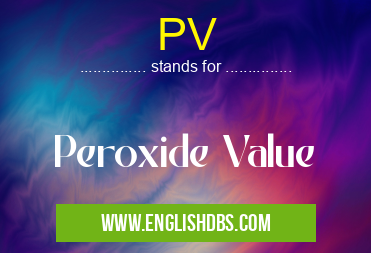What does PV mean in CHEMISTRY
Peroxide Value (PV) is a measure of the amount of peroxides and hydroperoxides present in a fat or oil. These compounds are formed during the oxidation process, which can occur due to exposure to air, light, or heat. PV is expressed as the number of milliequivalents of peroxide oxygen per kilogram of fat or oil.

PV meaning in Chemistry in Academic & Science
PV mostly used in an acronym Chemistry in Category Academic & Science that means Peroxide Value
Shorthand: PV,
Full Form: Peroxide Value
For more information of "Peroxide Value", see the section below.
- PV stands for Peroxide Value, which measures the amount of peroxides in a sample.
PV Meaning in SCIENCE
- Peroxides are organic compounds that contain a peroxide bond (-O-O-).
- They are highly reactive and can cause oxidative damage to cells and tissues.
- PV measures the concentration of peroxides in a sample, typically expressed as milliequivalents of peroxide per kilogram of fat (meq/kg).
PV Full Form
- P - Peroxide
- V - Value
What does PV Stand for?
- PV represents the amount of peroxides present in a sample.
Essential Questions and Answers on Peroxide Value in "SCIENCE»CHEMISTRY"
What is Peroxide Value (PV)?
Why is Peroxide Value important?
PV is important because it indicates the extent of oxidation that has occurred in a fat or oil. High PV values are indicative of rancidity, which can lead to off-flavors, odors, and nutritional degradation. PV is also used as a quality control parameter in the food industry to ensure that fats and oils meet certain standards of freshness and quality.
How is Peroxide Value measured?
PV is typically measured using a titration method known as the iodometric method. This method involves reacting the fat or oil sample with potassium iodide and glacial acetic acid to liberate iodine. The amount of iodine liberated is then determined by titration with sodium thiosulfate, and the PV is calculated based on the amount of iodine consumed.
What is a typical Peroxide Value for different types of fats and oils?
PV values can vary depending on the type of fat or oil, as well as its storage conditions. However, typical PV ranges for different types of fats and oils are as follows:
- Refined vegetable oils: <10 meq O2/kg
- Unrefined vegetable oils: 10-20 meq O2/kg
- Animal fats: 5-15 meq O2/kg
- Fish oils: 10-25 meq O2/kg
What are the factors that can affect Peroxide Value?
Several factors can affect PV, including:
- Exposure to oxygen
- Exposure to light
- Exposure to heat
- Presence of catalysts, such as metals
- Storage conditions
Final Words:
- PV is a valuable metric for assessing the oxidative stability of fats and oils.
- High PV values indicate increased peroxide content, which can compromise product quality and safety.
- Measuring PV helps ensure the integrity of food products and protects consumers from potentially harmful substances.
PV also stands for: |
|
| All stands for PV |
